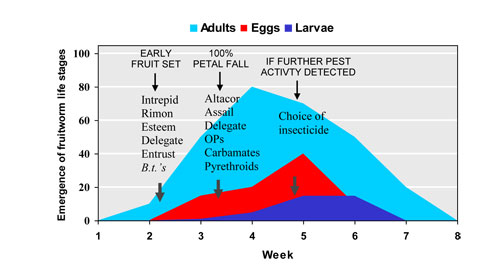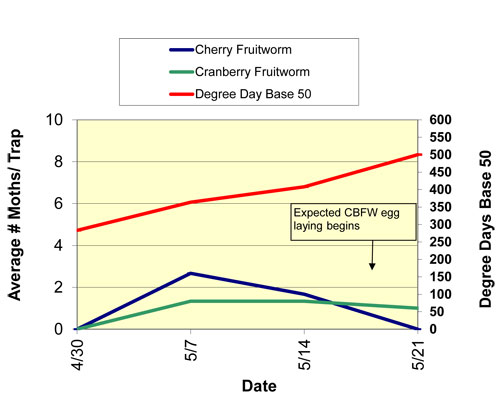Control options for fruitworms in blueberries
Performance characteristics of registered control materials for fruitworms can help guide management decisions in blueberry IPM.
Cherry fruitworm and cranberry fruitworm adult emergence is well underway in most blueberry producing areas of Michigan. The two flights appear to be closely synchronized this year, which can allow for common management tactics to control both species. With the current warming trend, we expect heavy egg deposition this week as most blueberries enter fruit set.
There is an array of insecticides available for control of fruitworms, but their performance characteristics are not all the same. It is important to refrain from using compounds that are toxic to pollinators when these insects are in your fields. Two products registered for use during bloom or in the presence of pollinators have provided consistent control of fruitworms in trials at the Trevor Nichols Research Center and at grower fields. These are the B.t. products (such as Dipel or Javelin) and the insect growth regulator Intrepid. These products must be consumed by fruitworm larvae to be effective, so they are best applied over the top of fruitworm eggs so they are ingested as the larvae emerge. B.t. products have short residual activity, typically around five days, so they need regular reapplication. These are best applied when daily temperatures reach 70°F so the larvae will actively feed and ingest the insecticide. Intrepid is more resistant to degradation, giving between seven and 14 days activity. Other options for control of cranberry fruitworm are the growth regulators Rimon and Esteem. These insecticides are highly active ovicides and they also disrupt the adult moth's ability to lay viable eggs, hindering the development of larvae. As with all insecticides, be sure to follow the label restrictions if making applications while bees are foraging in the fields. For all fruitworm control applications, excellent coverage of fruit clusters is required. This can be improved by the addition of a spreader-sticker to the spray water.
After 100 percent petal fall and removal of honey bees from the field, the range of options for fruitworm control increases with Guthion (las year of use, 1.5 lbs/acre limit), Imidan, Asana, Danitol, Mustang Max, Lannate and Sevin being some of the available broad-spectrum insecticides. With all these products, maintaining good coverage is still important to get residue to the parts of the berry where fruitworms are found. Recent research trials in Michigan have demonstrated that EPA designated Reduced Risk insecticides Intrepid, Assail, Altacor, Entrust and Delegate applied after petal fall can also achieve excellent control of fruitworms, with minimal negative impact on natural enemies such as parasitic wasps, ladybeetles and lacewings. Correct timing and coverage are critically important, so regular scouting of fields, use of sufficient spray volume to get good fruit coverage and selecting appropriate spreader-stickers can increase activity of most insecticides applied for fruitworm control.
The table and figures below are designed to summarize several key factors that can help you select an insecticide for your integrated pest management program for fruitworm control in blueberries.
Details of insecticide options and timing for fruitworm control in blueberries
|
Compound trade name |
Chemical class |
Life-stage activity |
Optimal spray timing |
Pollinator/ parasitoid toxicity rating * |
|
Guthion/Imidan |
Organophosphate |
Eggs, Larvae, Adults |
100% Petal Fall |
H |
|
Lannate/Sevin |
Carbamate |
Eggs, Larvae, Adults |
100% Petal Fall |
H |
|
Asana/Danitol/ Mustang Max |
Pyrethroid |
Eggs, Larvae, Adults |
100% Petal Fall |
H |
|
Altacor |
Diamide |
Larvae |
100% Petal Fall |
S |
|
Assail |
Neonicotinoid |
Eggs, Larvae |
100% Petal Fall |
M |
|
Entrust Delegate |
Spinosyn |
Eggs, Larvae |
Early fruit set over eggs |
M |
|
Dipel |
B.t. |
Larvae |
Early fruit set over eggs |
S |
|
Intrepid |
Growth regulator |
Larvae |
Early fruit set over eggs |
S |
|
Rimon |
Growth regulator |
Eggs, Larvae |
Early fruit set under eggs |
S |
|
Esteem |
Growth regulator |
Eggs, Larvae |
Early fruit set under eggs |
S |
* Pollinator/Parasitoid Toxicity rating; S – relatively safe, M – moderate toxicity, H – Highly Toxic.
Population emergence of fruitworm adults, eggs and larvae and the
optimal timing to begin sprays of different insecticide options. Follow
the label caution for bees if making applications during bloom.

2012 Trevor Nichols Research Complex Trapline Data: Fennville, MI

Dr. Isaacs' work is funded in part by MSU's AgBioResearch.



 Print
Print Email
Email